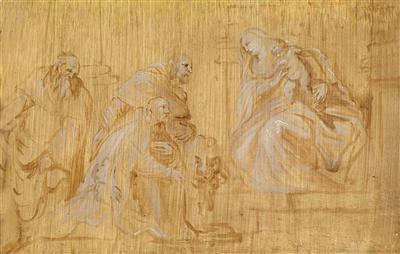Workshop of Anthony van Dyck

(Antwerp 1599–1641 London)
The Virgin and Child, worshipped by three saints,
oil on panel, 16.1 x 24.4 cm, framed
Provenance:
collection of Gunnar Asgeir Sadolin (1874–1955);
Lasson Gallery, London (1965, as Anthony van Dyck).
Literature:
The Burlington Magazine, no. 751, vol. 107, October 1965, p. XXIV, with ill. (as A. van Dyck);
H. Vey et al., Van Dyck, A complete catalogue of the paintings, New Haven 2004, p. 257, below no. III. 16 (as copy of the painting by a follower of van Dyck held by the Kunsthaus, Zurich).
Following a visit to the monastery of Chanoinesse de Saint Augustin in Antwerp in 1781, Sir Joshua Reynolds described a painting to which this preparatory sketch belongs, “In a little chapel the virgin and Infant Christ, by Van Dyck, a priest kneeling, an angel behind directing his attention to the virgin...” (see Sir J. Reynolds, A journey in Flanders and Holland in the year 1781, London 1797, new edition Cambridge 1996, p. 39). This painting, now lost, was first documented in 1644. A sketch which matches the description of the Antwerp altarpiece is to be found in the collection of Count Antoine Seilern, Prince’s Gate Collection, London. Our sketch differs from this version in various ways, which is why it has only been tentatively catalogued by Vey, who evidently had only seen the black/white illustration in the Burlington Magazine. There are two further versions of this composition, which also differ from the picture in the Seilern collection. One is in the Museum Boijmans van Beuningen in Rotterdam, and the other in the collection of Koetser in the Kunsthaus in Zurich. In the Rotterdam sketch, the Virgin has been replaced by St. Peter, and the lion depicted in our painting is also present. The Madonna appears in the variant in Zurich, but the angels featured in the Rotterdam and London versions do not. The pictorial type exhibited by the sketch is based on Venetian models, in particular the work of Titian. One can assume a date of circa 1627/28, that is, his early second Antwerp period. Given that this was an important commission for van Dyck also for personal reasons (his sister, Anna was a nun at the St. Augustine nunnery), it is probable that the development of the iconographical programme for the altarpiece, now lost, consisted of several preparatory stages. It is also possible that the workshop produced a ‘ricordo’ of these pictorial ideas, which would accord with van Dyck’s workshop practice.
Expert: Dr. Alexander Strasoldo
 Dr. Alexander Strasoldo
Dr. Alexander Strasoldo
+43 1 515 60 403
oldmasters@dorotheum.com
17.04.2013 - 18:00
- Odhadní cena:
-
EUR 15.000,- do EUR 20.000,-
Workshop of Anthony van Dyck
(Antwerp 1599–1641 London)
The Virgin and Child, worshipped by three saints,
oil on panel, 16.1 x 24.4 cm, framed
Provenance:
collection of Gunnar Asgeir Sadolin (1874–1955);
Lasson Gallery, London (1965, as Anthony van Dyck).
Literature:
The Burlington Magazine, no. 751, vol. 107, October 1965, p. XXIV, with ill. (as A. van Dyck);
H. Vey et al., Van Dyck, A complete catalogue of the paintings, New Haven 2004, p. 257, below no. III. 16 (as copy of the painting by a follower of van Dyck held by the Kunsthaus, Zurich).
Following a visit to the monastery of Chanoinesse de Saint Augustin in Antwerp in 1781, Sir Joshua Reynolds described a painting to which this preparatory sketch belongs, “In a little chapel the virgin and Infant Christ, by Van Dyck, a priest kneeling, an angel behind directing his attention to the virgin...” (see Sir J. Reynolds, A journey in Flanders and Holland in the year 1781, London 1797, new edition Cambridge 1996, p. 39). This painting, now lost, was first documented in 1644. A sketch which matches the description of the Antwerp altarpiece is to be found in the collection of Count Antoine Seilern, Prince’s Gate Collection, London. Our sketch differs from this version in various ways, which is why it has only been tentatively catalogued by Vey, who evidently had only seen the black/white illustration in the Burlington Magazine. There are two further versions of this composition, which also differ from the picture in the Seilern collection. One is in the Museum Boijmans van Beuningen in Rotterdam, and the other in the collection of Koetser in the Kunsthaus in Zurich. In the Rotterdam sketch, the Virgin has been replaced by St. Peter, and the lion depicted in our painting is also present. The Madonna appears in the variant in Zurich, but the angels featured in the Rotterdam and London versions do not. The pictorial type exhibited by the sketch is based on Venetian models, in particular the work of Titian. One can assume a date of circa 1627/28, that is, his early second Antwerp period. Given that this was an important commission for van Dyck also for personal reasons (his sister, Anna was a nun at the St. Augustine nunnery), it is probable that the development of the iconographical programme for the altarpiece, now lost, consisted of several preparatory stages. It is also possible that the workshop produced a ‘ricordo’ of these pictorial ideas, which would accord with van Dyck’s workshop practice.
Expert: Dr. Alexander Strasoldo
 Dr. Alexander Strasoldo
Dr. Alexander Strasoldo
+43 1 515 60 403
oldmasters@dorotheum.com
|
Horká linka kupujících
Po-Pá: 10.00 - 17.00
old.masters@dorotheum.at +43 1 515 60 403 |
| Aukce: | Obrazy starých mistr? |
| Typ aukce: | Salónní aukce |
| Datum: | 17.04.2013 - 18:00 |
| Místo konání aukce: | Wien | Palais Dorotheum |
| Prohlídka: | 06.04. - 17.04.2013 |
